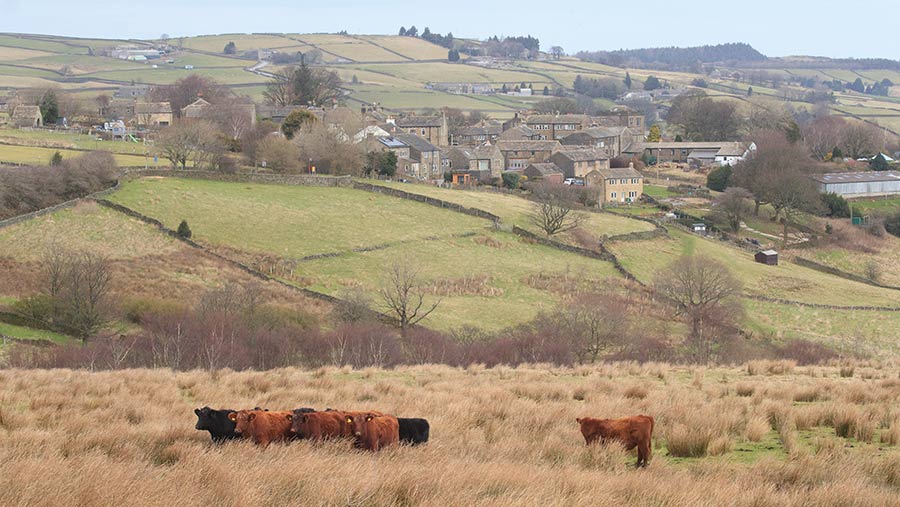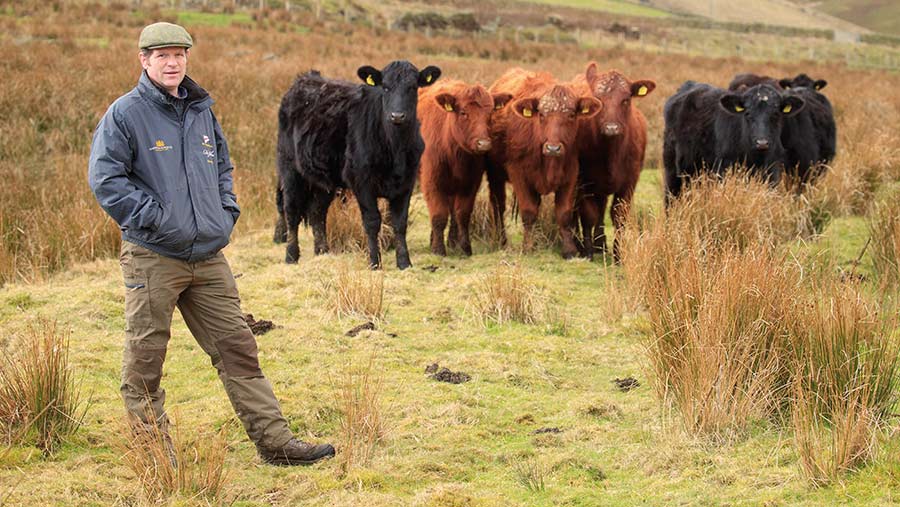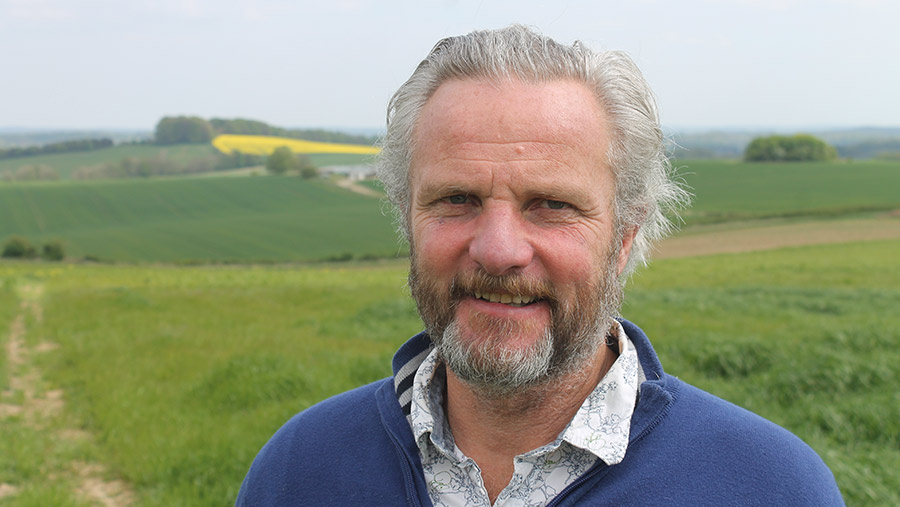How upland farmers are pooling resources to plug funding gap
 © Tim Scrivener
© Tim Scrivener As Defra starts to roll out more of its Environmental Land Management (ELM) scheme, ministers and civil servants have been quick to claim there is plenty in it for upland farmers.
Its recent announcement on new standards for the Sustainable Farming Incentive (SFI) and Countryside Stewardship (CS) emphasises that upland farmers will have “more than 100 actions in all schemes applicable to them”, helping them recoup any losses from Basic Payment Scheme (BPS) cuts.
See also: How trading natural capital credits could work for farmers
But English upland farmers remain sceptical, pointing out that some of the new SFI standards are simply existing CS standards rebadged, and suggesting the payment rates on offer, based on “income foregone”, are still too low.
Yet the cuts to the BPS, on which upland farmers are more dependent than most, continue unabated, leaving them deeply concerned about how they might plug the gaps, let alone be adequately rewarded for the environmental services they already deliver.
These concerns have been uppermost in the minds of members of two farmer cluster groups in the Peak District – the Hope Valley and the Bradfield Farmers clusters – who have worked together to form the new Peakland Environmental Farmers (PEF) group.
Commitment
Officially launching on Friday 17 February, the PEF has already secured the commitment of 53 farmers covering a total area of 26,060ha.
The new group is being modelled closely on the existing Environmental Farmers Group (EFG) in Hampshire (see “EFG – where is it now”), and is supported by the Game and Wildlife Conservation Trust (GWCT), the Moorland Association, the Peak District Moorland Group and the NFU.
How it works in practice
Joining Peakland Environmental Farmers is initially free, but in time there will be a joining fee to cover the running costs.
By pooling resources, individual farmers will be able to participate in the trade in natural capital, without the associated risks of going it alone in what is a fledgling market.
Any trading in natural capital will be overseen by the Game and Wildlife Conservation Trust’s Natural Capital Advisory service, and whatever revenue is obtained will be directed towards those farmers taking specific actions.
However, an equalisation metric will ensure that all co-op members will derive some benefit.
GWCT chief executive Teresa Dent says the loss of the BPS is a major driver.
“Farmers in the uplands are creating some of the most nature-rich areas of the country, and are happy to do even more, yet they are facing the loss of the BPS, which we estimate will take £22m out of the PEF area.
“It is essential they find other ways of recouping that funding.”
Mrs Dent says the hope is that, by coming together, farmers in the PEF will be able to “harness their scale through member co-operation” to both deliver good environmental outcomes and gain better access to ELM funding – in particular, the Landscape Recovery tier, which will be launching another 25 pilot projects this year.
Alternative funding
But group facilitator Chloe Palmer has her eye on other funding streams too, to help secure a just reward for the public goods farmer members are already providing.
“The farmers in the two clusters I look after are doing amazing things for the environment – for example, improving soil health, undertaking wader surveys, collecting data to drive land management improvements, replacing fences with hedges, and more,” she says.
“They are managing their land in a way that benefits biodiversity and stores lots of carbon. The public is already deriving great benefit.”
One potential source of alternative funding to reward this work will be from organisations such as the Heritage Lottery Fund or the Esmée Fairbairn Foundation.
“Unlike the farmer clusters, the PEF has co-operative status, which should help us tap into these sources,” says Ms Palmer.
Trading nature
Natural capital trading is another objective – with the PEF setting group baselines for things such as carbon loading, biodiversity and water quality, and then selling any credits to businesses looking for offsets.
“The EFG in Hampshire has been making great progress in this area, though it’s not so easy for us in the Peak District,” says Ms Palmer.
“Our water quality is already excellent and it is hard to see how we can improve carbon storage in much of the area.
“However, there are opportunities in peatland restoration – the government already has funding schemes we can access – and some farms may have scope for biodiversity net gain.”
Another opportunity for the group will be in flood management, with the area covering the Rivers Don and Derwent catchments.
Any efforts to slow the flow of water to more populated areas through land management actions could well provide funding from local authorities.
Case study: James Howard, Lane Farm, Holme, West Yorkshire
Farming at high altitude, but also close to the urban fringe, James Howard is fully aware of the need for environmental delivery.

James Howard © Tim Scrivener
His mix of owned and tenanted land runs to about 1,200ha and is predominantly used for grazing native-breed sheep and Aberdeen Angus cattle, but large swathes are also entered into a Higher Level Stewardship (HLS) scheme.
The emphasis here is on moorland restoration and revegetation of peatlands, though parts of his in-bye land are also managed to encourage breeding ground for waders, such as lapwing, oyster catchers and especially curlew.
“Our HLS agreement, which runs out in 2024, is very important to the financial viability of our farm, though I also have a natural interest in conservation, which I am keen to pass on to my children,” says Mr Howard.
But the steady removal of the Basic Payment Scheme is a big concern, and he is eager to find other ways to fund his environmental work, which is one reason he has signed up to the Peakland Environmental Farmers (PEF) group.
“If we’re to continue delivering environmental gains, we will have to be supported for it,” he says.
“We need to collaborate with policymakers. Farmers know best what works on their individual farms, so should be directly involved in designing the schemes.”
Working together through the new group may also help meet the costs of delivering on the new environmental standards.
“We need investment and we can share equipment,” says Mr Howard. “But more than that we should share knowledge, particularly about what works best for the environment.”
And then there is the opportunity to trade in natural capital.
“This is not a big one for me, as I find it hard to see how we can really trade carbon offsets while farming this area, though I can see opportunities for biodiversity net gain,” he says.
He does, however, see opportunities for PEF to access funds from the emerging Environmental Land Management scheme, which should, in time, benefit all members of the new group.
EFG – where is it now?
The Environmental Farmers Group covering the River Avon catchment in Hampshire is coming towards the end of its first year as an entity, having drawn membership from seven established farmer clusters.
The group’s aims are to deliver cleaner water, increase biodiversity (especially bird species), and achieve net-zero carbon by 2040 – with a view to trading any gains in all three for the benefit of members.
Since Farmers Weekly first visited the Environmental Farmers Group (EFG) last April, numbers have continued to grow, from about 82 “expressions of interest” covering 40,000ha to 130 expressions of interest covering 60,000ha.
Of these, 80 farmers are now fully signed up – paying the £1.25/ha joining fee – with some 38,000ha covered by the scheme.
“This is pretty much where we hoped to be,” says EFG chairman Rob Shepherd.

Rob Shepherd © MAG/Philip Clarke
“The farmed environment has continued to improve, with further gains in target species such as lapwing and turtle doves, and we have also made good progress with trading.”
Mr Shepherd says there are an estimated £15m worth of natural capital trades in the pipeline, and the first full trade – worth £1m to the group – has been completed with a water company.
It was always recognised that trading carbon credits was going to be a challenge, as even though there are two approved carbon codes – one for woodland and one for peatland in England – measuring carbon sequestration has yet to be standardised.
Biodiversity net gain is easier to quantify, especially since the development of Natural England’s Biodiversity Metric 3.1.
Mr Shepherd says the EFG is making good headway with the local authorities in Hampshire and Wiltshire, which recognise what the EFG can deliver in terms of measurable biodiversity net gain – something that is now a legal requirement for certain infrastructure projects.
But the real progress has been in delivering phosphate and nitrate reductions for the water catchment, which is where most deals are being progressed.
“In practice this is for things like planting reed beds and farming arable land in a regenerative way,” says Mr Shepherd.
“Even though it takes a long time for the benefits to show in the river water itself, we know that changing farming practices will deliver and this is what our customers are paying for.
“It is set up so that the individual farmer taking the action gets the lion’s share, but our equalisation model ensures that everyone in the group gets something.
“So we’re very pleased with the progress so far, but recognise we have to keep moving the monetisation forward, in parallel with the environmental delivery, if we are to keep our farmer members on side.”
